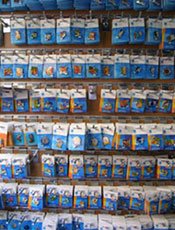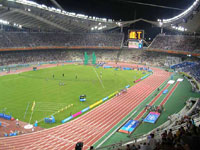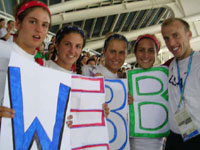
WEB JOURNAL FROM 2004 ATHENS OLYMPICS
 August 19, 2004
August 19, 2004
Athens
6:30 PM
Caption: Pins from an Olympic Games store in the Plaka, Athens.
Pins, pins, pins! Olympic pins that is! They are everywhere and everyone is wearing them. There are literally hundreds and hundreds of different types of Olympic pins. Some represent the flags of the individual countries, others the specific national teams (usually traded by the athletes,) and still others are “Olympic” in the sense that they represent one Olympic sport or another (see photo.) These are the most popular ones for tourists. Some show the ancient and the modern event side by side, for instance wrestling discus, javelin and long jump. Some are historical, showing scenes from the first Modern Olympic Games in Athens in 1896, others show only the Olympic rings and the date. Riding the Metro gives me a good chance to study the pins that the athletes and the fans are wearing. They appear on hats, on bags, on shirts, on belts and even on sandals! There are numerous stores to buy pins and other Olympic clothing and mementoes in the Plaka, the area of Athens that is at the base of the Akropolis on the north and east. Flags are also doing a brisk business all over town. Many fans wear the gigantic flags as capes as they walk around town and attend the events. There are special flags that can be worn as hats by some. Others buy more modest sized flags simply for waving. Many kids (including ours) display flags as transfers on their faces or on their arms. We have also bought some United States flags for the various events although I must confess some concern about being too obvious about our nationality. A product of the times I guess. But isn’t it too bad!
The shot put event of track and field was held yesterday in the ancient stadium at Olympia, in the Western Peloponnesos. Both men and women competed there during the day. Some reports that I have read have stated that it is the first time that women ever competed in this stadium, since the ancient Olympic Games were limited to men and boys. But this is not true! There was a separate festival, in honor of Hera, for unmarried girls that took place in this very stadium. Admittedly there was no event in the shot put for the girls, but nor was there the shot put event for the men or boys either! The girls only ran a footrace, in three age categories. The race is described as approximately 5/6 the distance of the mens’ and boys’ race of one length. The Hera games were organized by a committee of 16 women representing the different cities of Elis and the girls, if victorious, could dedicate an image of themselves in the sacred grove at Olympia. They could also take part in the dedication of the cow to Hera. There are several miniature bronze images of the girls running in this race at Olympia in the new Ancient Olympic Games Museum at Olympia. We know that married women were not allowed to watch the mens’ and boys’ games, although unmarried girls could watch. Furthermore, we don’t know if the boys and men were allowed to watch the contests for unmarried girls.
DGR
PS There seems to be much relief in the air in Athens now that the Greek sprinters Kenteris and Thanou have withdrawn from the Olympic Games. Their case will be reviewed by the I.A.A.F. sometime in the future.
 August 21, 2004
August 21, 2004
Kifissia
2:30 PM
The Olympic track and field stadium was brimming with excitement last night with many interesting events. (Photo: Olympic Stadium, 10,000 m. in progress.) We witnessed an Olympic Record in the Men’s 10,000 m. by the 22 year old Keninsa Bekele of Ethiopia in a time of 27:05.10. What a fantastic race! In the competition were two other Ethiopians, Haile Gebrselassie, 31, looking for his third consecutive gold medal in the event and Sileshi Sihine. The three ran together for much of the race but at the end Bekele broke away and ran the final mile in a sizzling 4:01 to capture the Olympic Record!
 We also watched closely the Men’s 1500 m. trials that included three US athletes. Our daughters Sarah and Lizzie and their friends Anne-Marie and Patrice Boucher have been following the successes of Alan Webb for a number of years, including several great races at the Penn Relays. Alan Webb who won the Olympic Trials 1500 m. and who is the young US hope in the 1500 ran in the second heat. Unfortunately, he was spiked early in the race and finished a disappointing ninth. The girls had prepared signs to cheer for Alan Webb and prepared USA shirts! To our surprise, after the race, he came to sit with his family right in front of us. His fan club was ready. (Photo: left to right, Sarah Romano, Lizzie Romano, Patrice Boucher, Anne-Marie Boucher and Alan Webb.)
We also watched closely the Men’s 1500 m. trials that included three US athletes. Our daughters Sarah and Lizzie and their friends Anne-Marie and Patrice Boucher have been following the successes of Alan Webb for a number of years, including several great races at the Penn Relays. Alan Webb who won the Olympic Trials 1500 m. and who is the young US hope in the 1500 ran in the second heat. Unfortunately, he was spiked early in the race and finished a disappointing ninth. The girls had prepared signs to cheer for Alan Webb and prepared USA shirts! To our surprise, after the race, he came to sit with his family right in front of us. His fan club was ready. (Photo: left to right, Sarah Romano, Lizzie Romano, Patrice Boucher, Anne-Marie Boucher and Alan Webb.)
Earlier in the day we had been to the same stadium for the morning events. The stadium is attractive both in the day time and at night. The new roof does help to block the sun during the daylight hours, although it appears to trap the heat in the evening. Security in the stadium and elsewhere in the area of the Olympic Games is visible, from the blimp and the helicopters above, to the armed guards at the fences and the police on the streets.
The organization of the Olympic track and field events is extremely good. The events go off exactly on time, the scoreboards are clearly visible from the seats, the volunteers who administer the facility are flexible, courteous and helpful. The only complaint that we have at all is that the food that is provided at the concessions is fairly drab, hot dogs and potatoes. You need to eat before you go the Olympics!!
DGR